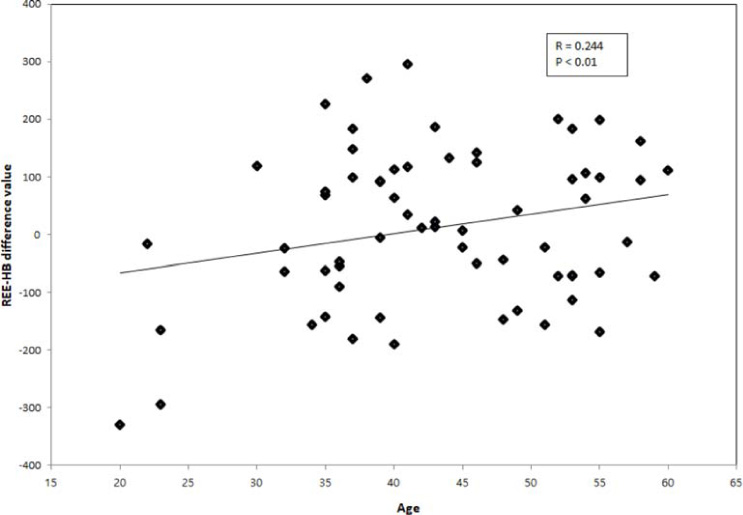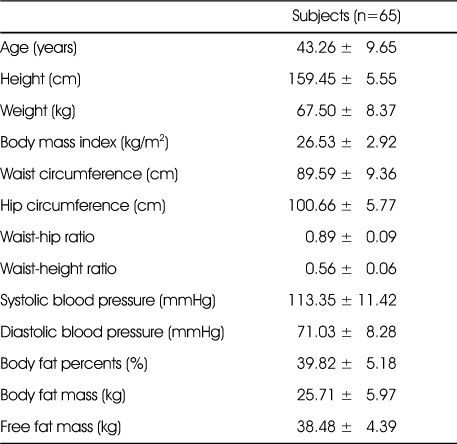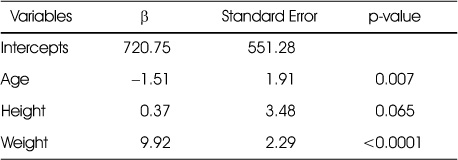Articles
- Page Path
- HOME > Korean J Community Nutr > Volume 23(5); 2018 > Article
-
Research Article
- Comparison of Predicted and Measured Resting Energy Expenditure in Overweight and Obese Korean Women
-
Ji-Sook Park, Jung-Eun Yim

-
Korean Journal of Community Nutrition 2018;23(5):424-430.
DOI: https://doi.org/10.5720/kjcn.2018.23.5.424
Published online: October 31, 2018
1Department of Food & Nutrition, Changwon National University, Changwon, Korea, Student.
2Department of Food & Nutrition, Changwon National University, Changwon, Korea, Professor.
- Corresponding author: Jung-Eun Yim, Ph.D. Department of Food and Nutrition, Changwon National University, Changwon 51140, Korea. Tel: (055) 213-3517, Fax: (055) 281-7480, jeyim@changwon.ac.kr
Copyright © 2018 The Korean Society of Community Nutrition
This is an Open-Access article distributed under the terms of the Creative Commons Attribution Non-Commercial License (http://creativecommons.org/licenses/by-nc/3.0/) which permits unrestricted non-commercial use, distribution, and reproduction in any medium, provided the original work is properly cited.
- 843 Views
- 3 Download
- 1 Crossref
Abstract
-
Objectives
- The purpose of this study was to compare predictions and measurements of the resting energy expenditure (REE) of overweight and obese adult women in Korea.
-
Methods
- The subjects included 65 overweight or obese adult women ranging in age from 20~60 with a recorded body mass index (BMI) of 23 or higher. Their height, weight, waist-hip ratio, and blood pressure were measured. The investigator also measured their body fat, body fat percentage, and body composition of total weight without fat using Dual energy X-ray absorptiometry (DXA) and measured resting energy expenditure by indirect calorimetry. Measured resting energy expenditures were compared with predictions from six methods: Harris-Benedict, Mifflin, Owen, WHO-WH, Henry-WH, and KDRI.
-
Results
- Harris-Benedict predictions showed the smallest differences from measured resting energy expenditure at an accurate prediction rate of 70%. The study analyzed regression between measured resting energy expenditure and body measurements including height, weight and age. The formula proposed by this research is as follows: Proposed REE equation for overweight and obese Korean women = 721 − (1.5 × age) + (0.4 × height) + (9.9 × weight).
-
Conclusions
- These findings suggest that age is a significant variable when predicting resting energy expenditure in overweight and obese women. Therefore, prediction of resting energy expenditure should consider age when determining energy requirements in overweight and obese women.
Acknowledgments
Acknowledgments
- 1. WHO. Obesity and overweight. [internet]. WHO; 2017; cited 18 Oct 2017]. Available from: http://www.who.int/.
- 2. Ministry of Health and Welfare, Korea Centers for Disease Control and Prevention. Korea Health Statistics 2016: Korea National Health and Nutrition Examination Survey (KNHANES VI-3). Sejong: Ministry of Health and Welfare; 2017.
- 3. Abdelaal M, Roux CW, Docherty NG. Morbidity and mortality associated with obesity. Ann Transl Med 2017; 5(7): 161.ArticlePubMedPMC
- 4. Seo YW, Lee HJ, Yun KE, Park HS. Energy intake and resting energy expenditure of middle-aged obese Korean women. Korean J Obes 2009; 18(1): 31-37.
- 5. Poehlman ET. Exercise and its influence on resting energy metabolism in man. Med Sci Sports Exerc 1989; 21(5): 515-525.PubMed
- 6. Ravussin E, Harper IT, Rising R, Bogardus C. Energy expenditure by doubly labeled water: validation in lean and obese subjects. Am J Physiol 1991; 261(3 Pt 1): E402-E409.ArticlePubMed
- 7. Johnston SL, Souter DM, Tolkamp BJ, Gordon IJ, Illius AW, Kyriazakis I, et al. Intake compensates for resting metabolic rate variation in female C57BL/6J mice fed high-fat diets. Obesity 2007; 15(3): 600-606.ArticlePubMed
- 8. Stewart CL, Goody CM, Branson R. Comparison of two systems of measuring energy expenditure. JPEN J Parenter Enteral Nutr 2005; 29(3): 212-217.ArticlePubMedPDF
- 9. Frankenfield D, Roth-Yousey L, Compher C. Comparison of predictive equations for resting metabolic rate in healthy nonobese and obese adults: a systematic review. J Am Diet Assoc 2005; 105(5): 775-789.ArticlePubMed
- 10. Harris JA, Benedict FG. A biometric study of basal metabolism in man. Washington: Carnegie institution of Washington; 1919.
- 11. Joint FAO/WHO/UNU. Energy and protein requirements: report of a joint FAO/WHO/UNU Expert Consultation. World Health Organ Tech Rep Ser 1985; 724: 201-206.
- 12. Owen OE. Resting metabolic requirements of men and women. Mayo Clin Proc 1988; 63(5): 503-510.ArticlePubMed
- 13. Mifflin MD, St Jeor ST, Hill LA, Scott BJ, Daugherty SA, Koh YO. A new predictive equation for resting energy expenditure in healthy individuals. Am J Clin Nutr 1990; 51(2): 241-247.ArticlePubMed
- 14. Henry CJ. Basal metabolic rate studies in humans: measurement and development of new equations. Public Health Nutr 2005; 8(7A): 1133-1152.ArticlePubMed
- 15. Son HR, Yeon SE, Cho JS, Kim EK. The measurements of the resting metabolic rate (RMR) and the accuracy of RMR predictive equations for Korean farmers. Korean J Community Nutr 2014; 19(6): 568-580.Article
- 16. Choi SH, Jo MW, Shin DS. Effects of the 8-week resistance exercise on body composition, serum hormone profiles and feeding patterns of obese females. Korean J Nutr 2004; 37(10): 888-898.
- 17. Lee JH. Treatment of obesity. Korean J Community Nutr 1990; 29(3): 307-320.
- 18. Yim JE, Kim YS, Choue R. Effects of age on changes of body composition through caloric restriction in overweight and obese women. J Nutr Health 2013; 46(5): 410-417.Article
- 19. Ministry of Health and Welfare and Korea Centers for Disease Control and Prevention. Korea Health Statistics 2014: Korea National Health and Nutrition Examination Survey [KNHANESVI-2]. Sejong: Ministry of Health and Welfare; 2015.
- 20. Neeland IJ, Turer AT, Ayers CR, Powell-Wiley TM, Vega GL, Farzaneh-Far R, et al. Dysfunctional adiposity and the risk of prediabetes and type 2 diabetes in obese adults. JAMA 2012; 308(11): 1150-1159.ArticlePubMedPMC
- 21. Derumeaux-Burel H, Meyer M, Morin L, Boirie Y. Prediction of resting energy expenditure in a large population of obese children. Am J Clin Nutr 2004; 80(6): 1544-1550.ArticlePubMed
- 22. Lee GH, Kim MH, Kim EK. Accuracy of predictive equations for resting metabolic rate in Korean college students. Korean J Community Nutr 2009; 14(4): 462-473.
- 23. Nam AY, Lee SY, Lee KJ, Park SB. The relationship between resting metabolic rate and cardiovascular risk factors in the obesity women. Korean J Obes 2008; 17(2): 73-81.
- 24. Park JA, Kim KJ, Yoon JS. A comparison of energy intake and energy expenditure in normal-weight and over-weight Korean adults. Korean J Community Nutr 2004; 9(3): 285-291.
- 25. Daly JM, Heymsfield SB, Head CA, Harvey LP, Nixon DW, Katzeff H, et al. Human energy requirements: overestimation by widely used prediction equation. Am J Clin Nutr 1985; 42(6): 1170-1174.ArticlePubMed
- 26. Ravussin E, Lillioja S, Knowler WC, Christin L, Freymond D, Abbott W, et al. Reduced rate of energy expenditure as a risk factor for body-weight gain. N Engl J Med 1988; 318(8): 467-472.ArticlePubMed
- 27. Weijs PJ. Validity of predictive equations for resting energy expenditure in US and Dutch overweight and obese class I and II adults aged 18-65y. Am J Clin Nutr 2008; 88(4): 959-970.ArticlePubMed
- 28. Bosy-Westphal A, Eichhorn C, Kutzner D, Illner K, Heller M, Muller MJ. The age-related decline in resting energy expenditure in human is due to the loss the loss of fat-free mass and to alteration in its metabolically active components. J Nutr 2003; 133(7): 2356-2362.PubMed
- 29. Kyle UG, Genton L, Hans D, Karsegard L, Solsman DO, Pichard C. Age-related differences in fat-free mass, skeletal muscle, body cell mass and fat mass between 18 and 94 years. Eur J Clin Nutr 2001; 55(8): 663.ArticlePubMedPDF
- 30. Hong SG. Energy balance and obesity. J Korean Beriatr 2000; 9(3): 1-5.
- 31. Goran MI, Kaskoun MC, Johnson RK. Determinants of resting energy expenditure in young children. J Pediatr 1994; 125(3): 362-367.ArticlePubMed
- 32. Ravussin E, Lillioja S, Knower WC, Christin L, Freymond D, Abbott WG, et al. Reduced rate of energy expenditure as a risk factor for body weight gain. N Engl J Med 1988; 318(8): 467-472.ArticlePubMed
- 33. Napoli R, Horton ES. Present knowledge in nutrition. 7th edition. Washing USA: ILSI press; 1998.
REFERENCES
Correlation coefficient between Age and Value of difference of Indirect Calorimetry method and Harris-Benedict formula method

Resting Energy Expenditure in overweight Korean women subjects

Values are Mean ± SD
Abbreviation: WH, Weight Height
1) Resting energy expenditure
2) [(predicted RMR − measured RMR) / measured RMR] × 100
3) Percentage of subjects predicted by formula within 90% to 110% of measured REE
4) Percentage of subjects predicted by formula < 90% of measured REE
5) Percentage of subjects predicted by formula > 110% of measured REE
6) Koreans Dietary Reference Intakes
Figure & Data
REFERENCES
Citations

- Resting energy expenditure in Korean type 2 diabetes patients: comparison between measured and predicted values
Ji-Sook Park, Sung-Rae Cho, Jung-Eun Yim
Nutrition Research and Practice.2023; 17(3): 464. CrossRef

Fig. 1
The Anthropometric variables in overweight Korean women subjects
Resting Energy Expenditure in overweight Korean women subjects
Values are Mean ± SD
Abbreviation: WH, Weight Height
1) Resting energy expenditure
2) [(predicted RMR − measured RMR) / measured RMR] × 100
3) Percentage of subjects predicted by formula within 90% to 110% of measured REE
4) Percentage of subjects predicted by formula < 90% of measured REE
5) Percentage of subjects predicted by formula > 110% of measured REE
6) Koreans Dietary Reference Intakes
Correlation coefficient between Resting Energy Expenditure and Anthropometric measurements
Values are Mean ± SD Abbreviation: WH, Weight Height 1) Resting energy expenditure 2) [(predicted RMR − measured RMR) / measured RMR] × 100 3) Percentage of subjects predicted by formula within 90% to 110% of measured REE 4) Percentage of subjects predicted by formula < 90% of measured REE 5) Percentage of subjects predicted by formula > 110% of measured REE 6) Koreans Dietary Reference Intakes

 KSCN
KSCN


 PubReader
PubReader Cite
Cite


